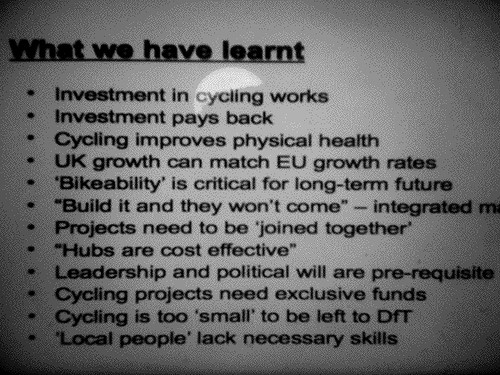Comments below are taken from the Cambridge Cycle Campaign Twitter feed reporting some of the highlights from a talk by Philip Darnton this evening
Good turnout for Phillip Darnton's talk! #live http://twitpic.com/58d55y
Darnton: Growth in cycling in the Cycling Demonstration Towns (b4 DfT killed them off) matched original 1970s Dutch starting growth
Darnton: DfT models assumed car drivers' time more valuable than ("poorer") cyclists' time in economic models
Darnton: DfT would agree now that cycling has high return rate for investment, £3.50 to £5 for each £1 invested- highest of all modes
Darnton: Growth in childhood obesity will make cycling investment become even more and more good value compared to other transport types
Darnton: "Build it and they will come" approach only works if it's any good and goes somewhere useful: needs where, who for, and marketing
Darnton: Encouraging cycling to school: no. 1 issue is actually theft of bike at school/home, not route safety
Darnton: Brilliant story re Bradley Stoke Secondary School: new school where kids are *expected* to cycle to school: it's just what is done
Darnton: Businesses etc people who act as 'hubs' most effective way to convert ppl to cycling than scattergun approach
Darnton: What we have learnt http://twitpic.com/58ddyq
Darnton paying tribute to former transport chief Brian Smith of @CambsCC who provided real leadership on cycling
Darnton: Cycling projects need exclusive funds - VERY important, but this at odds with new government agenda
Darnton: What UK has not learnt for cycling is Consistency & continuity of investment. Dutch decided to invest & still do
Darnton: Dutch to UK: "If you want lots of cycling you have to start investing 30 years and keep going!"
Darnton: DfT scrapping Cycling England means we have to start all over again, and loss of all the people with knowledge: crazy
Darnton: Another problem we (UK) haven't solved: how to attract women to cycling
Darnton: What we haven't learnt yet in the UK http://twitpic.com/58dj2t
Darnton: Hull's problem with boy racers etc tackled by refashioning & remodelling streets; solved lots of problems & high cycling
Darnton: High turnover of transport ministers over decades is symptom of many governments' lack of interest in transport & cycling solutions
Darnton: Marketing approach to cycling means targetting the maybe-cyclists rather than the hard-to-get-started people
Darnton: Getting kids to cycle: new life skill and captive audience



 posts
posts
